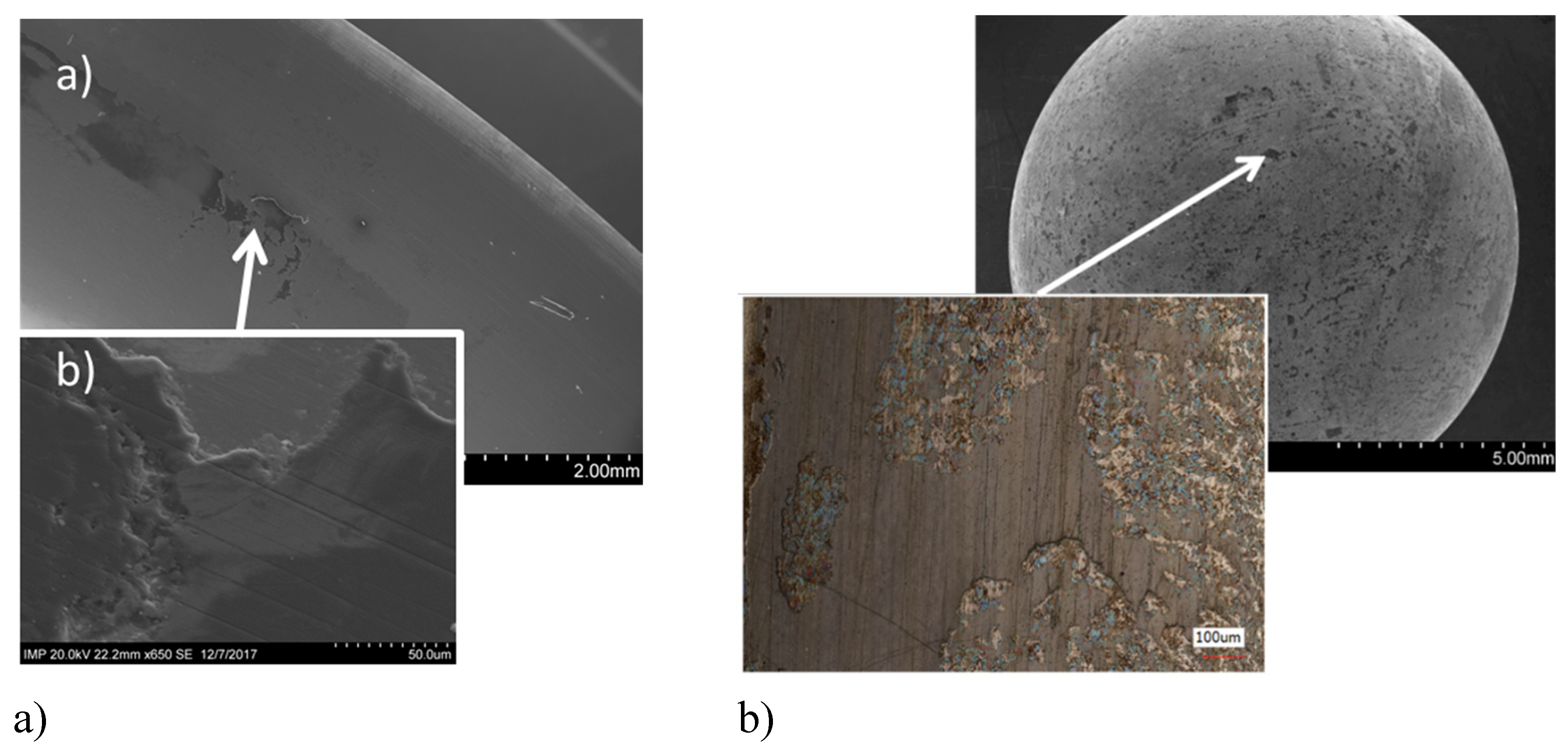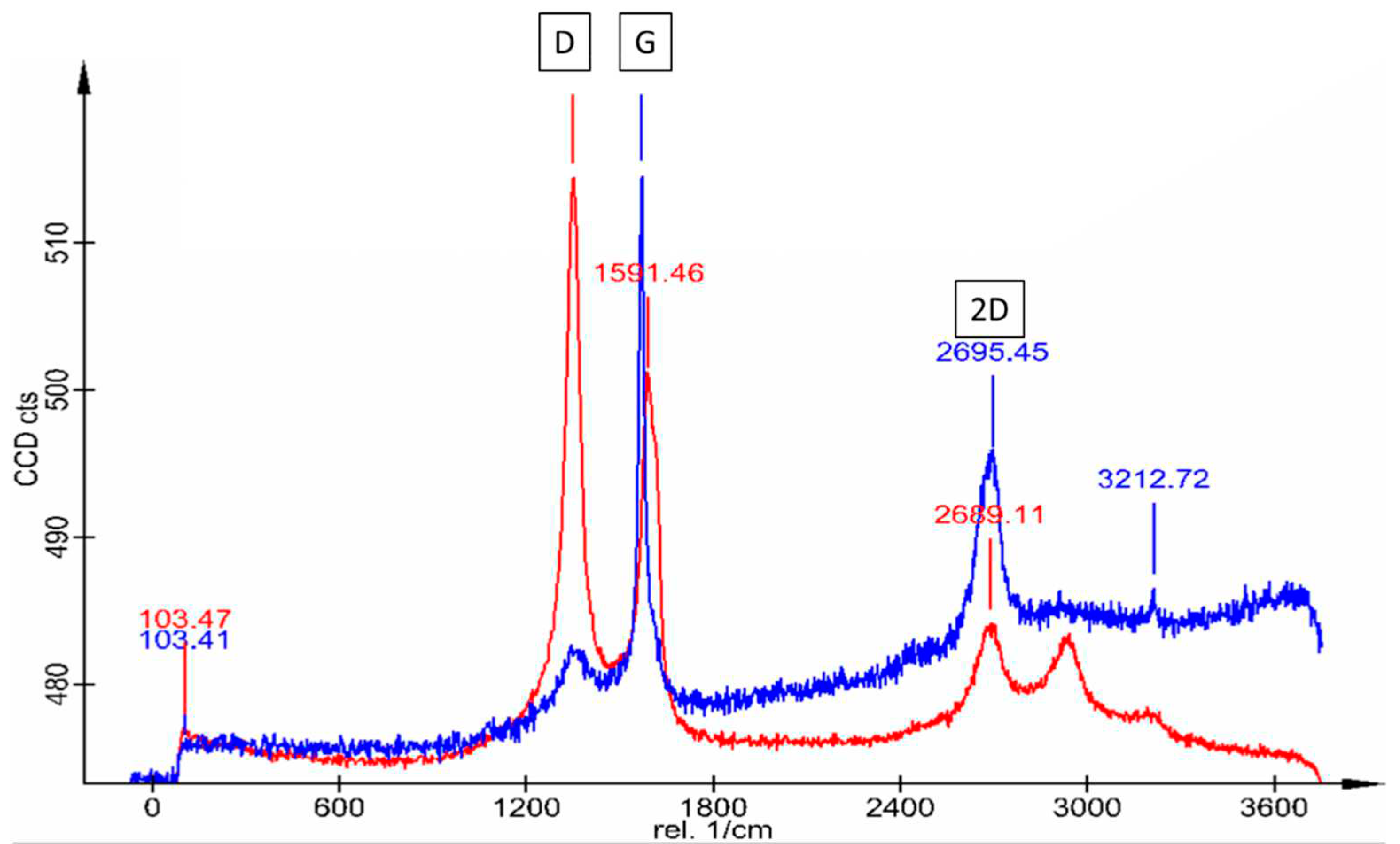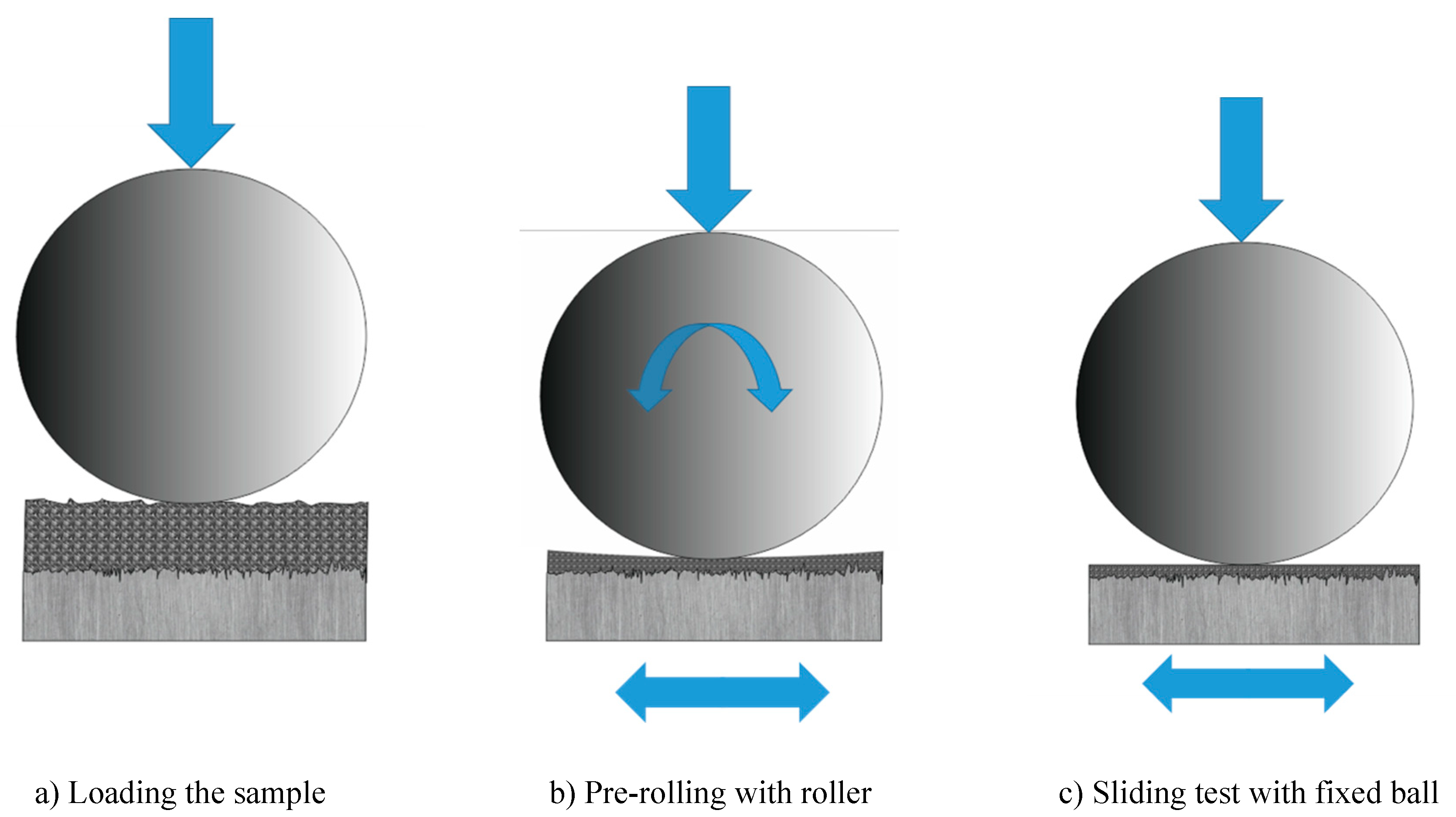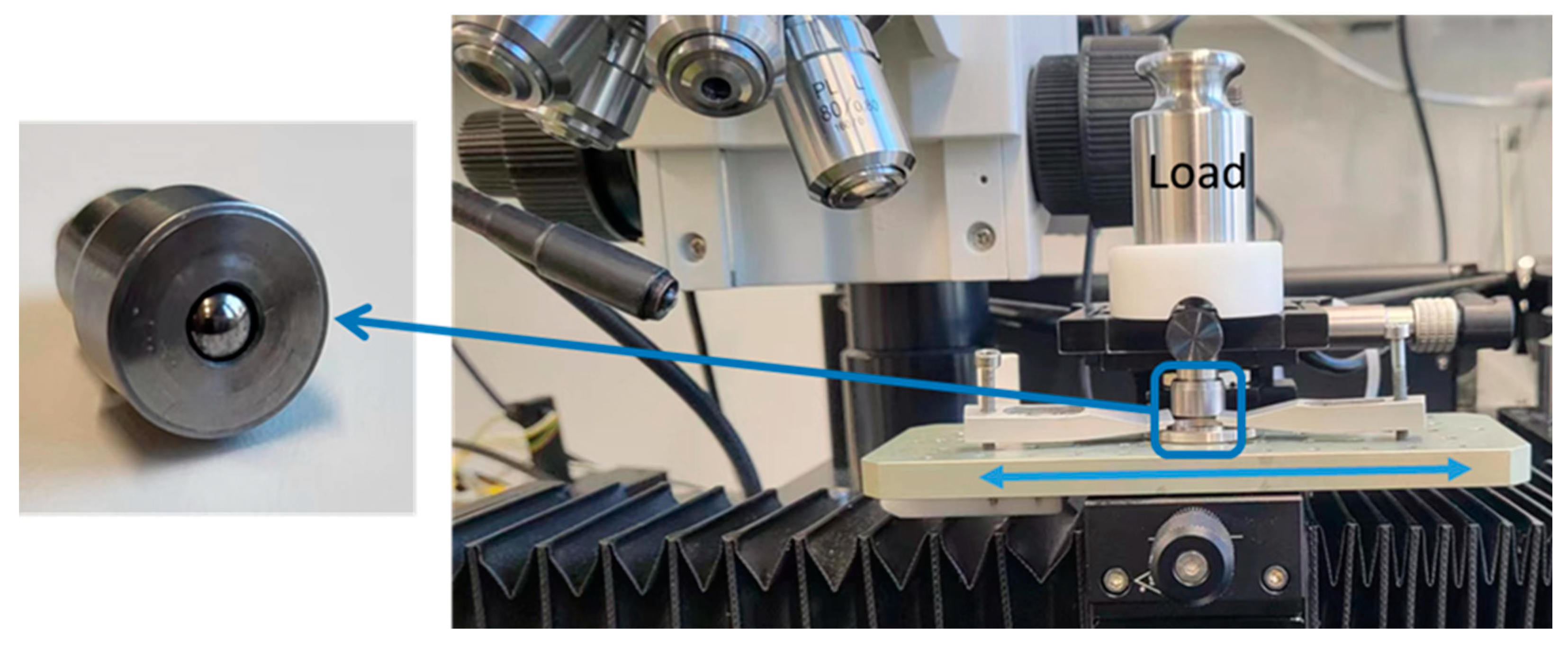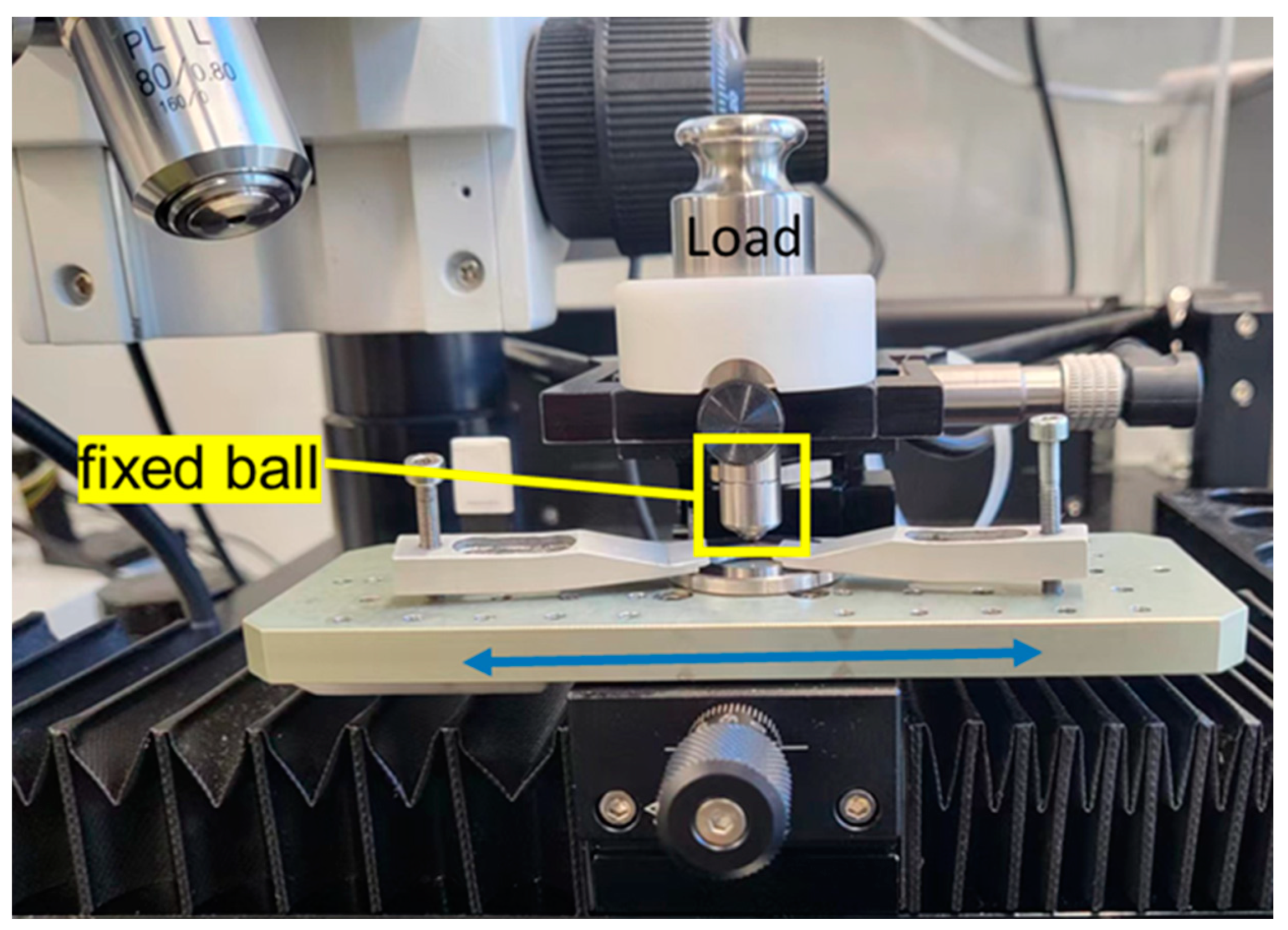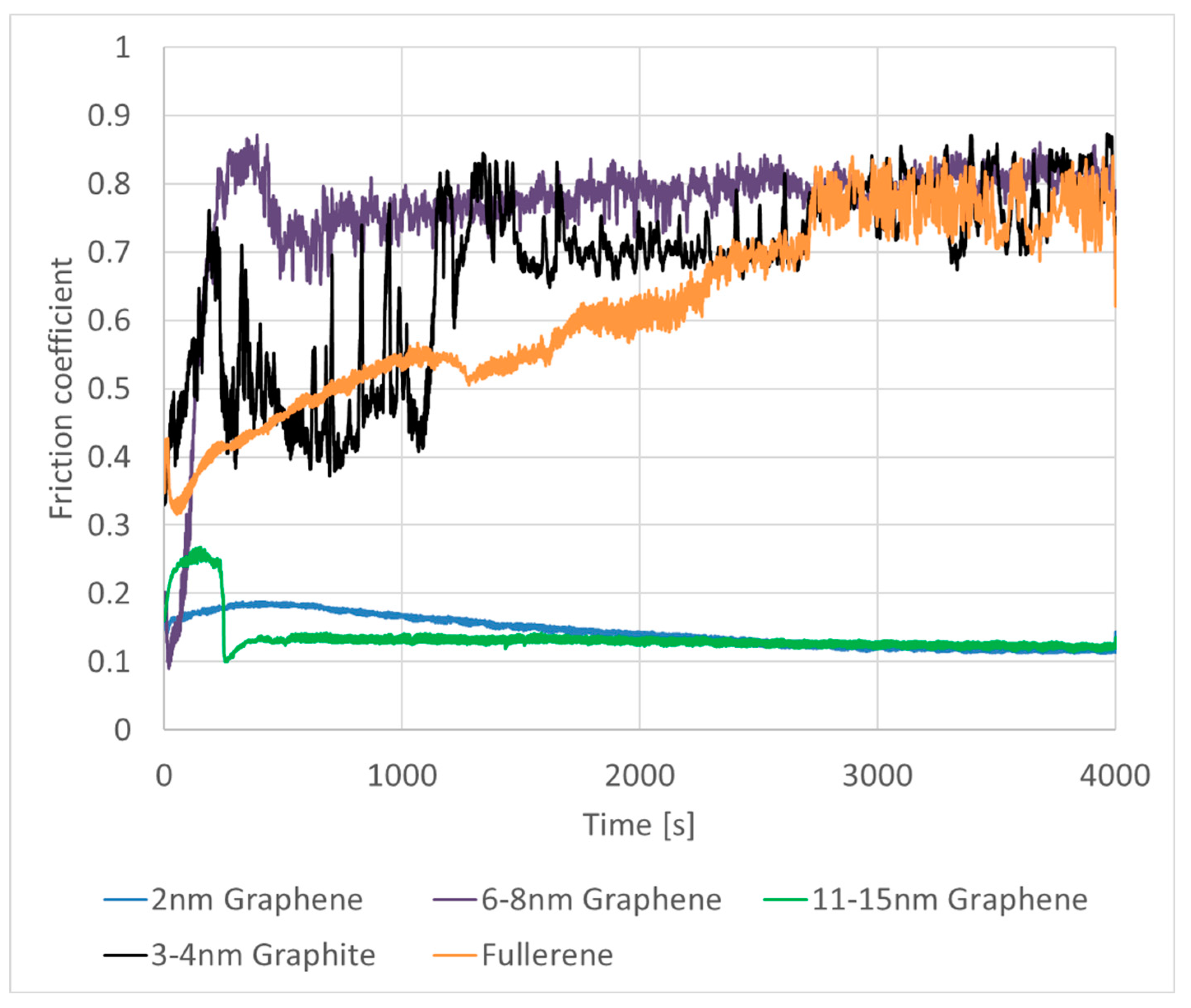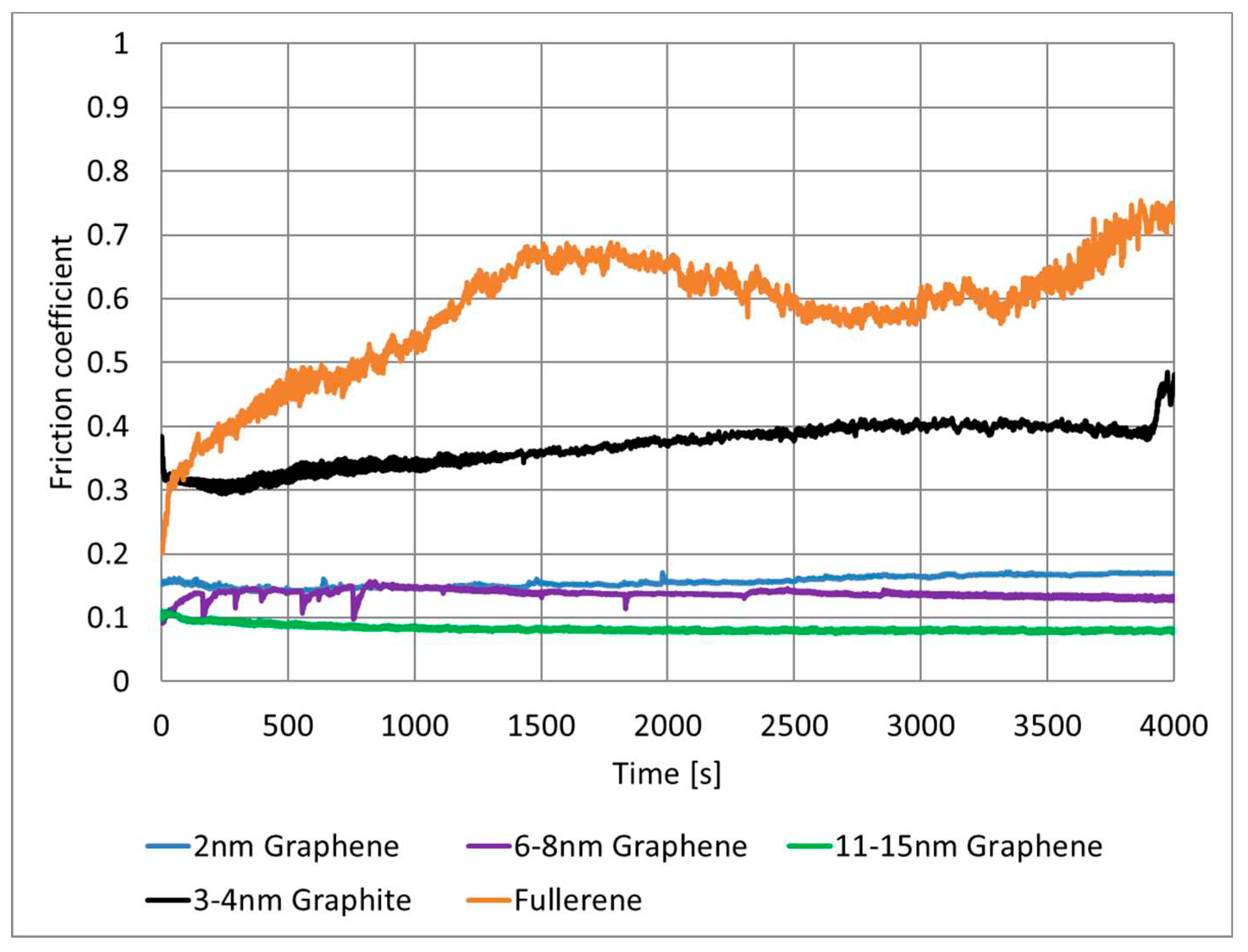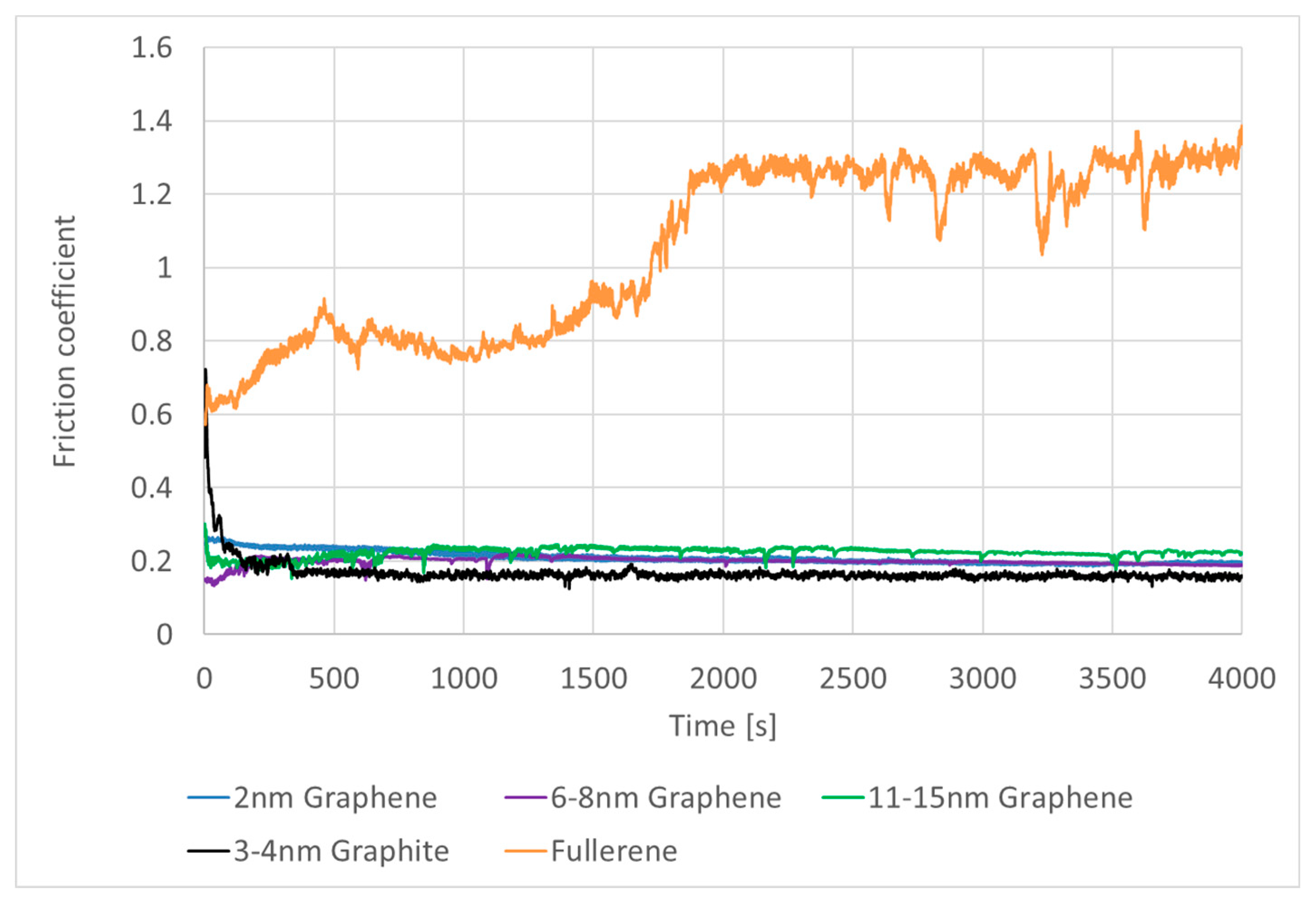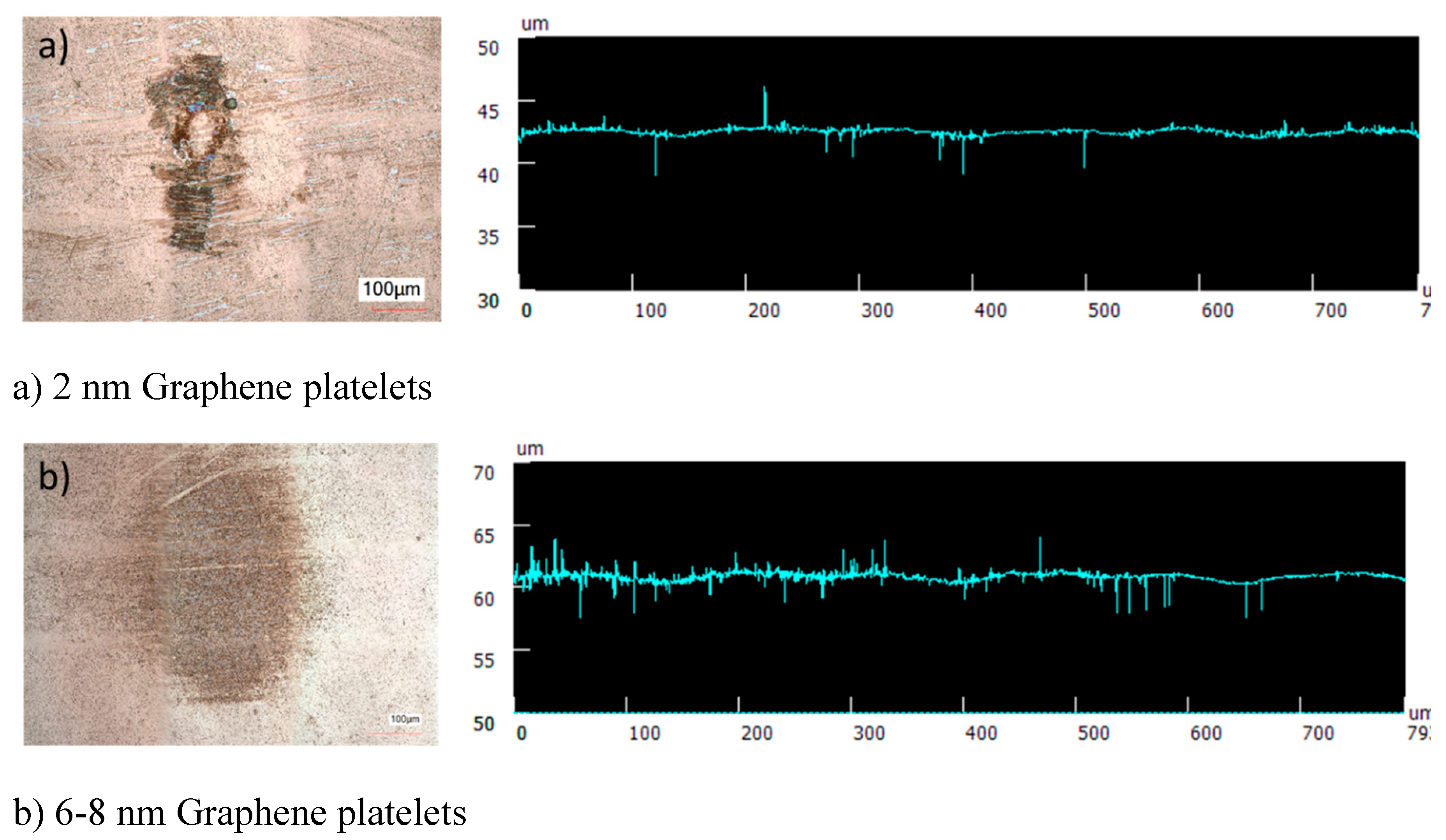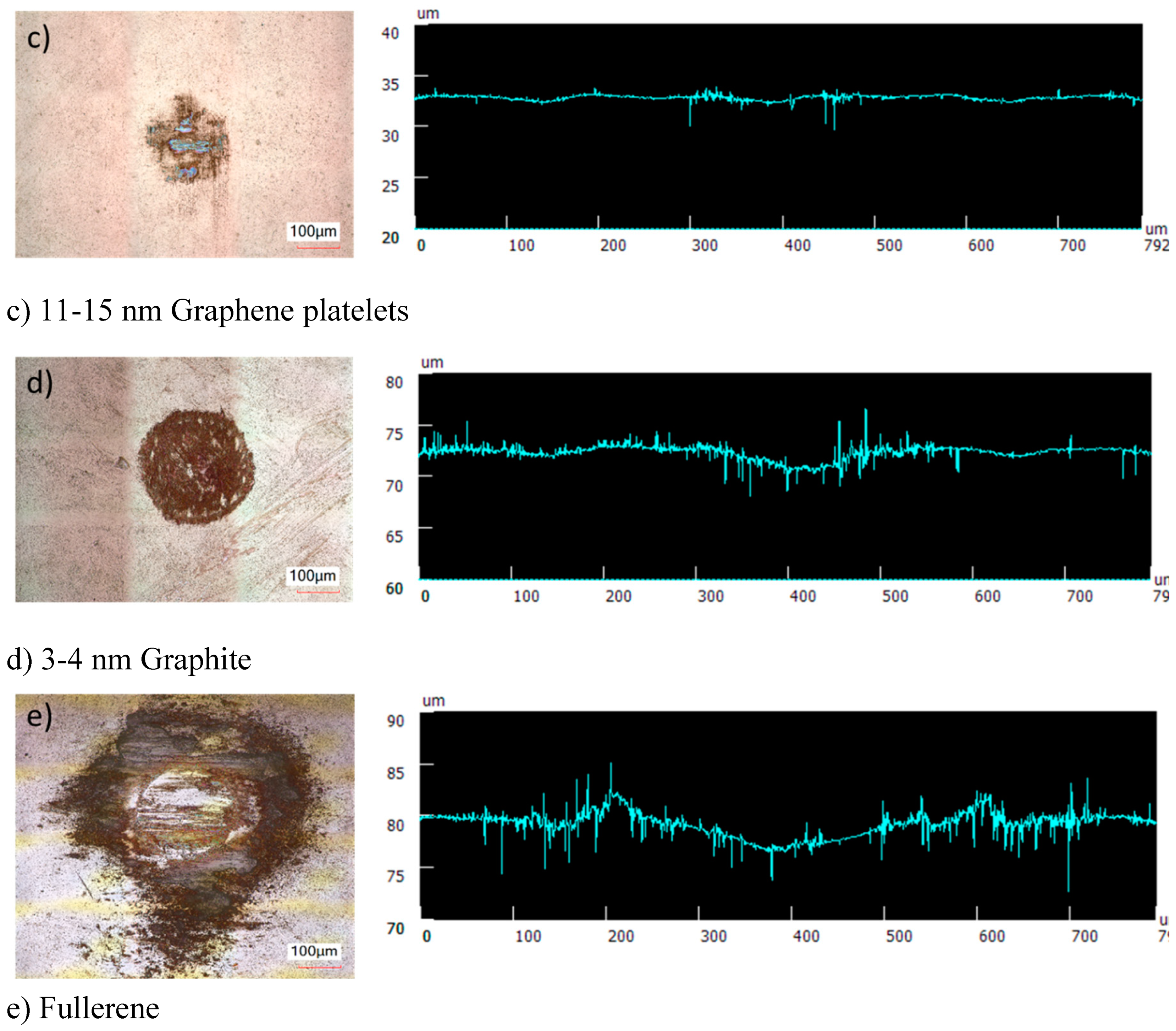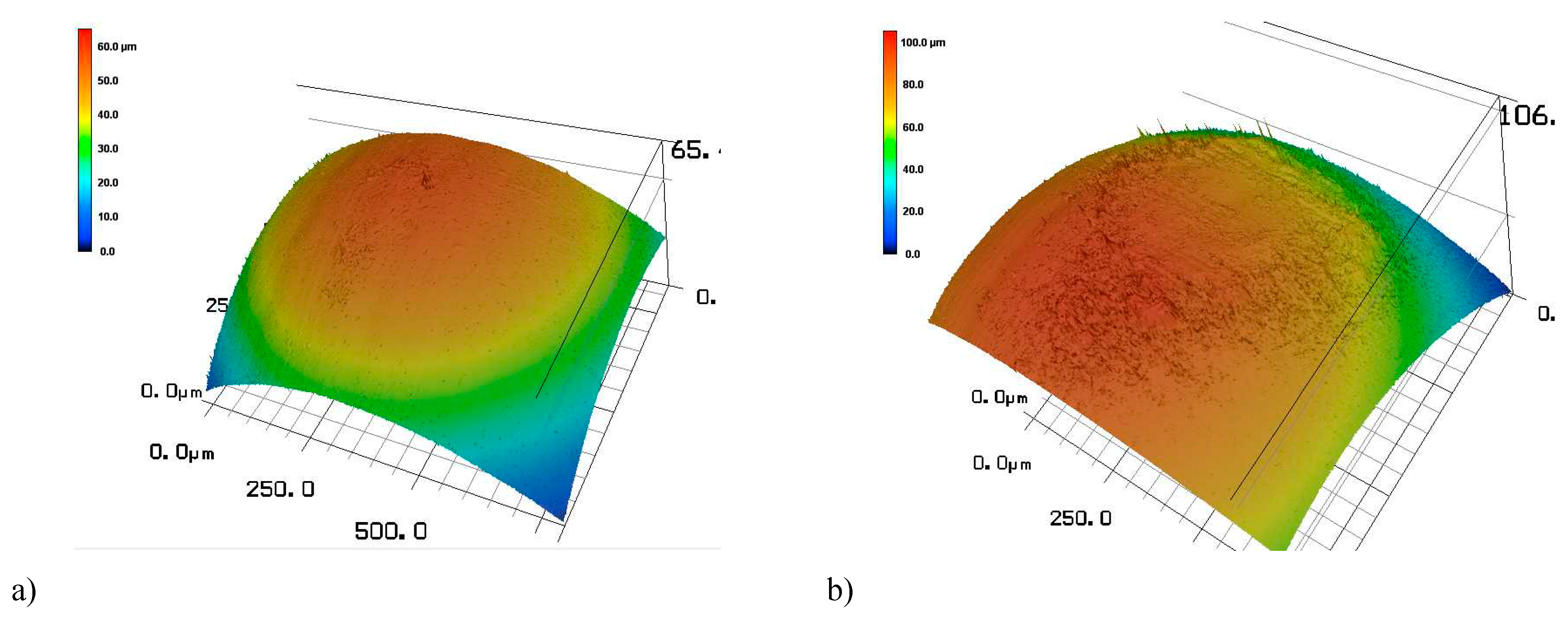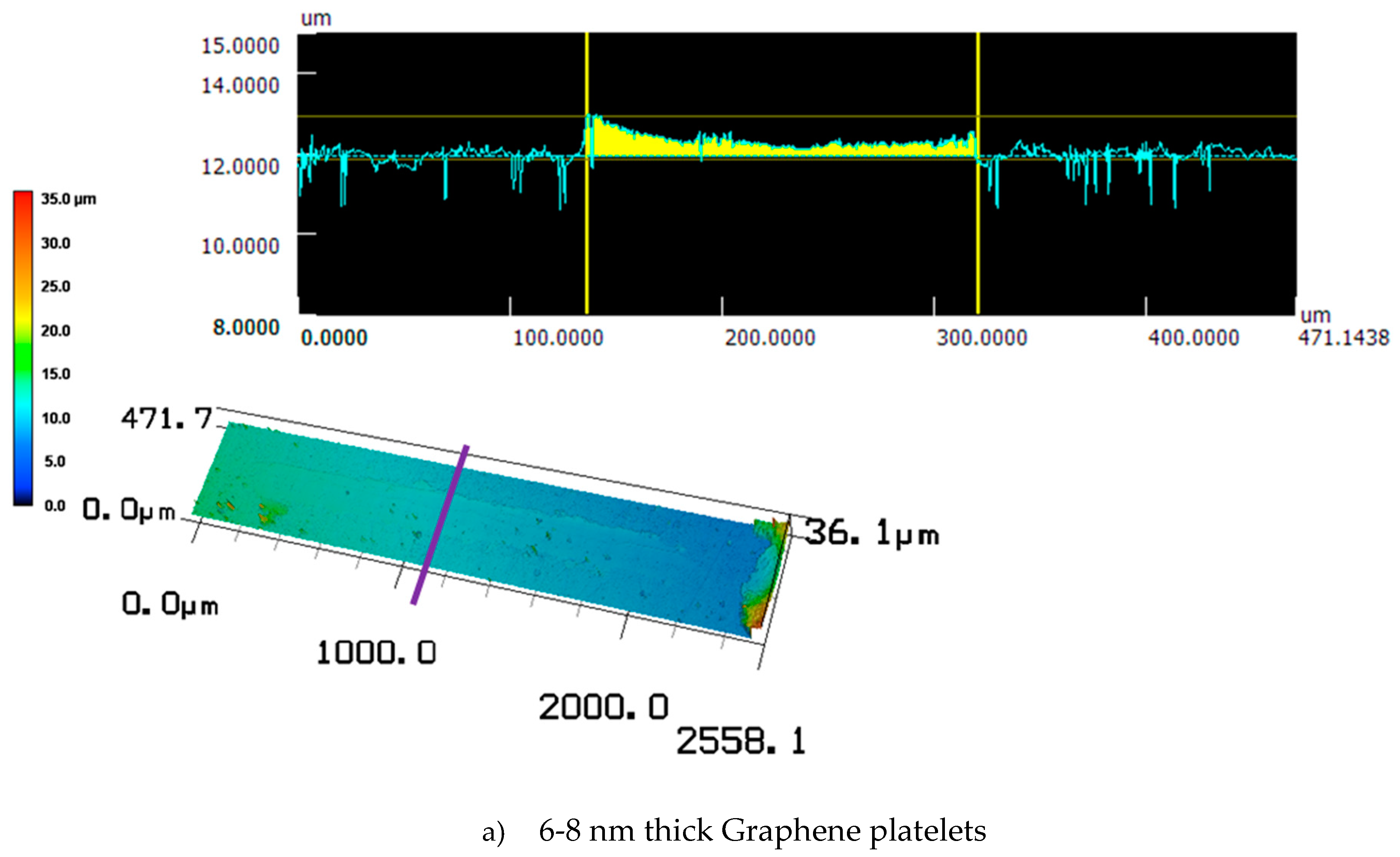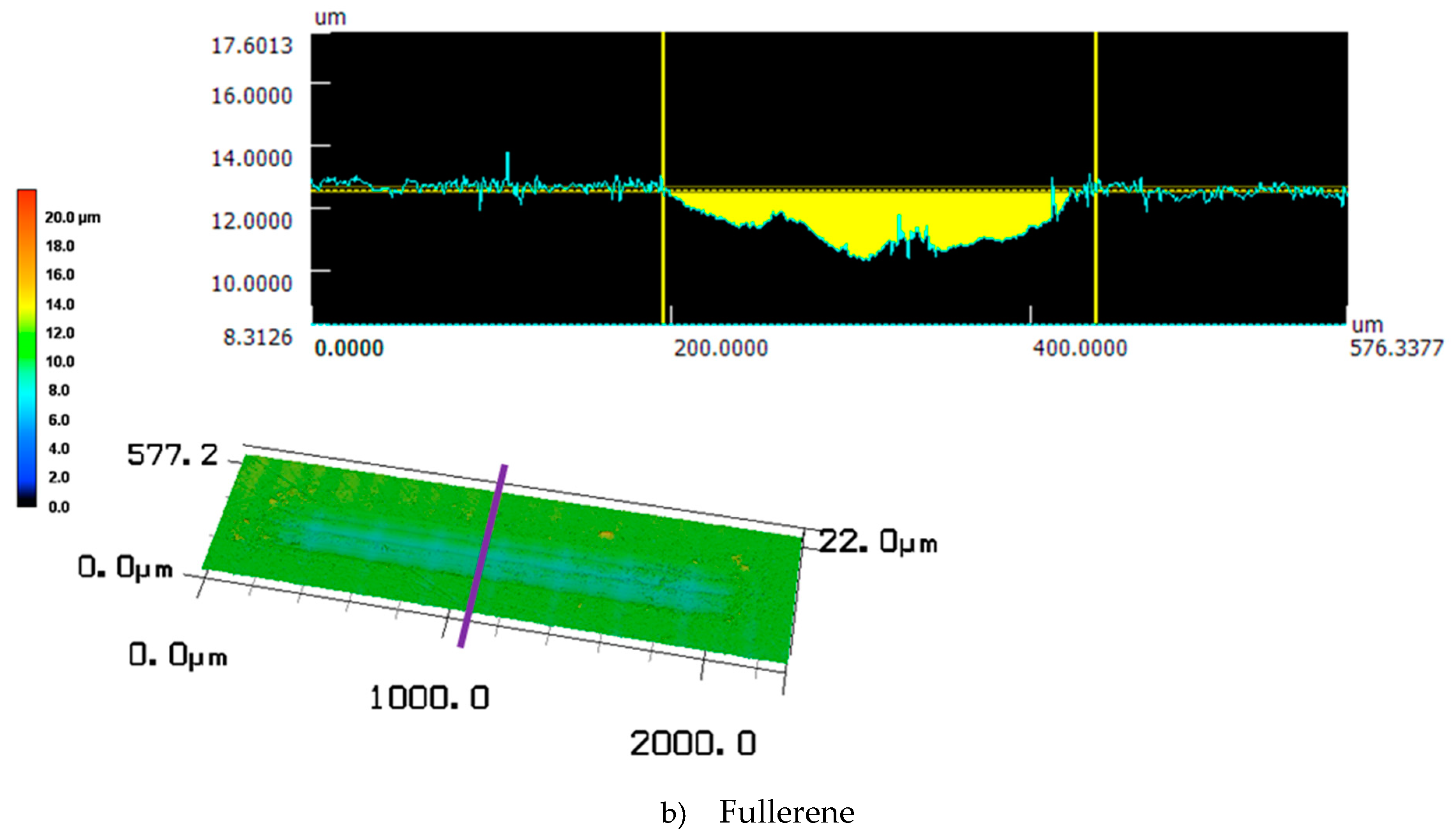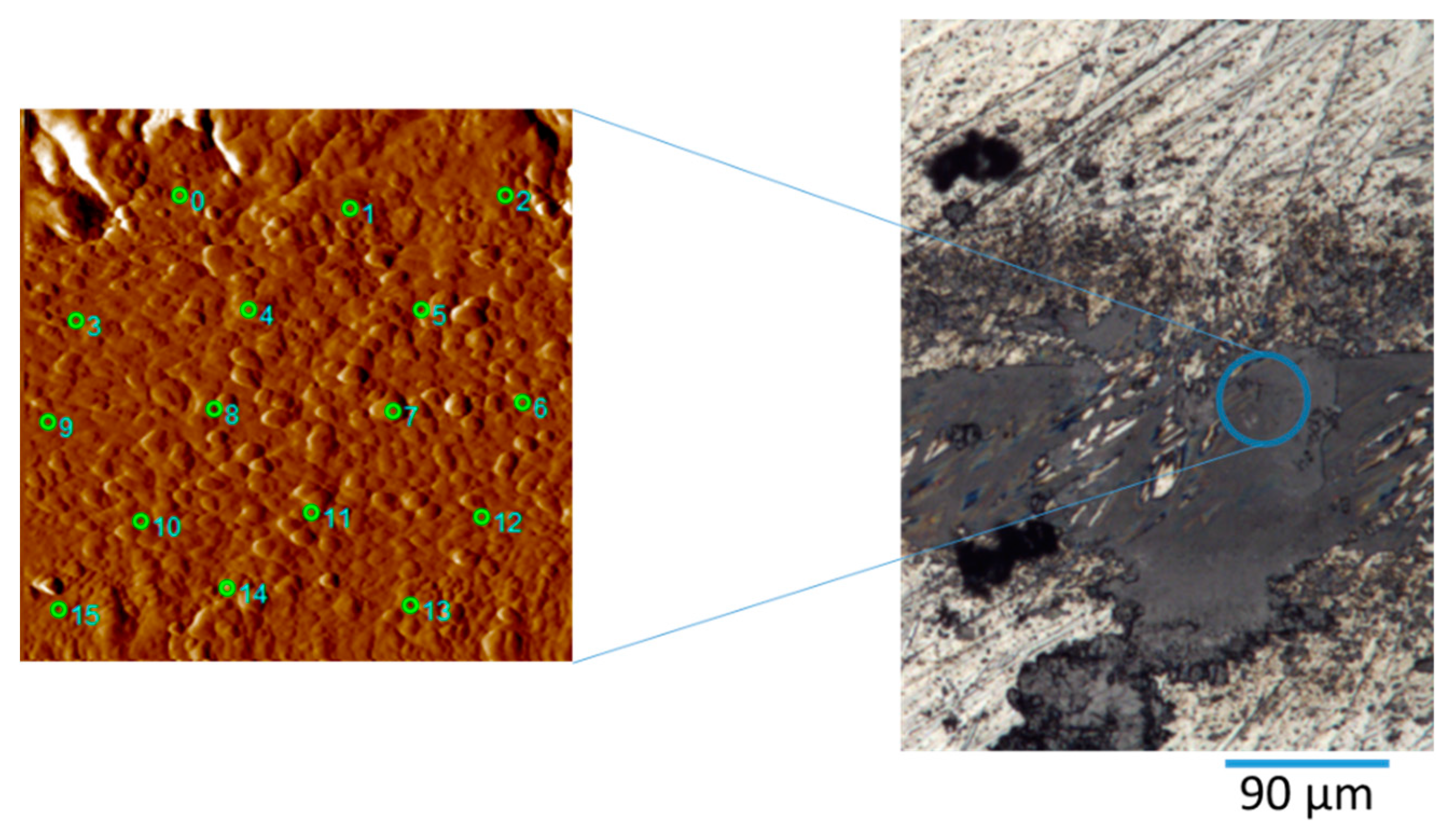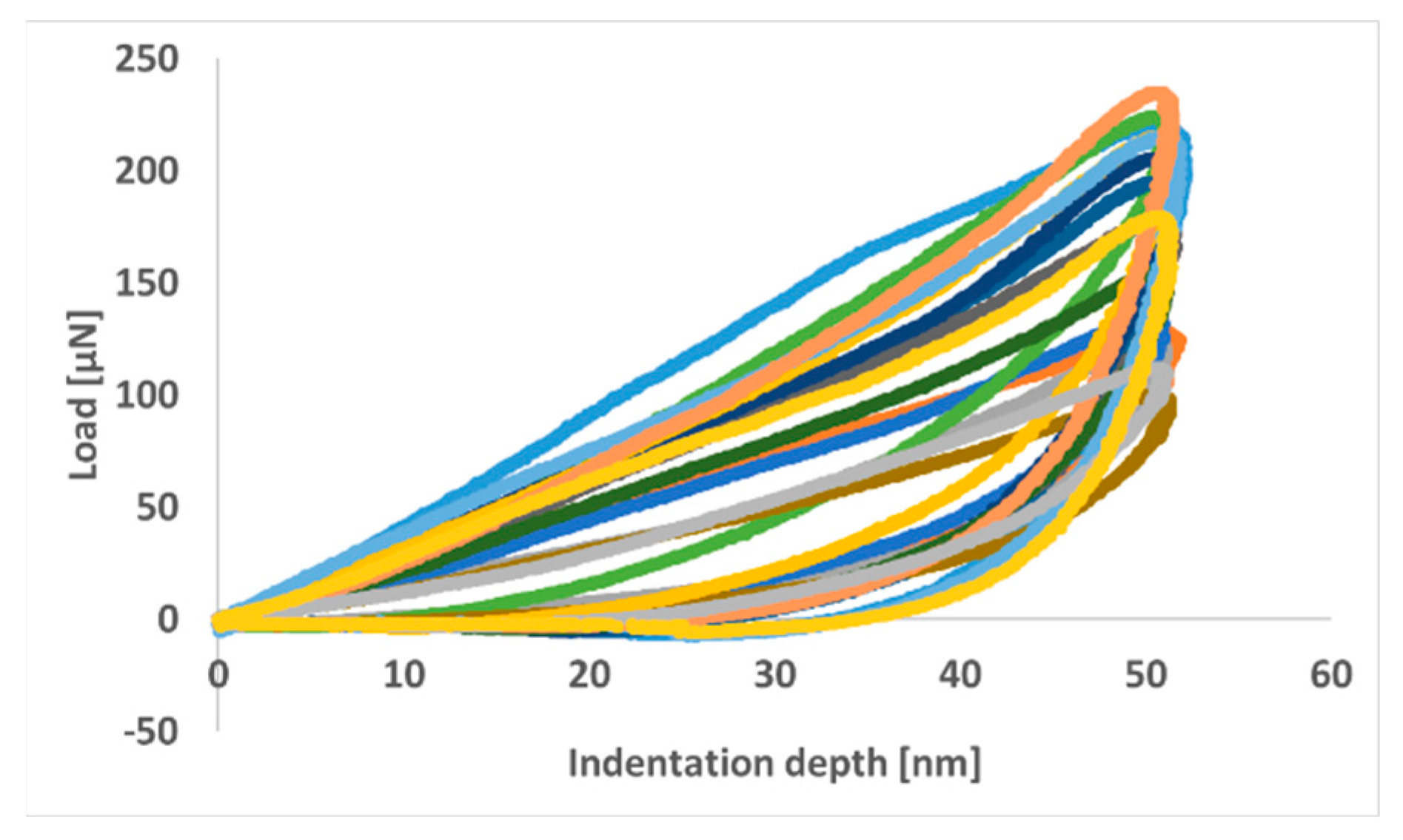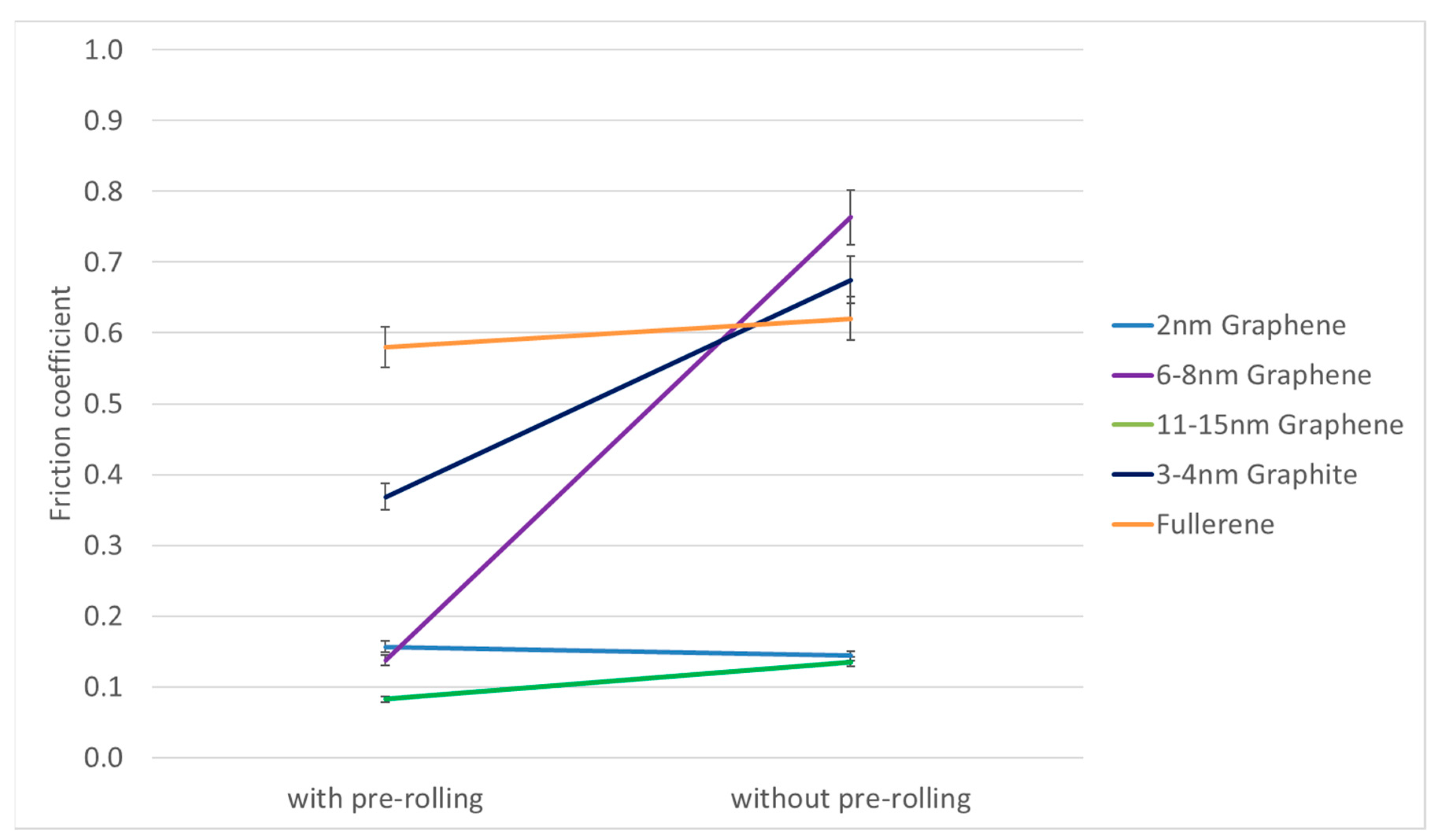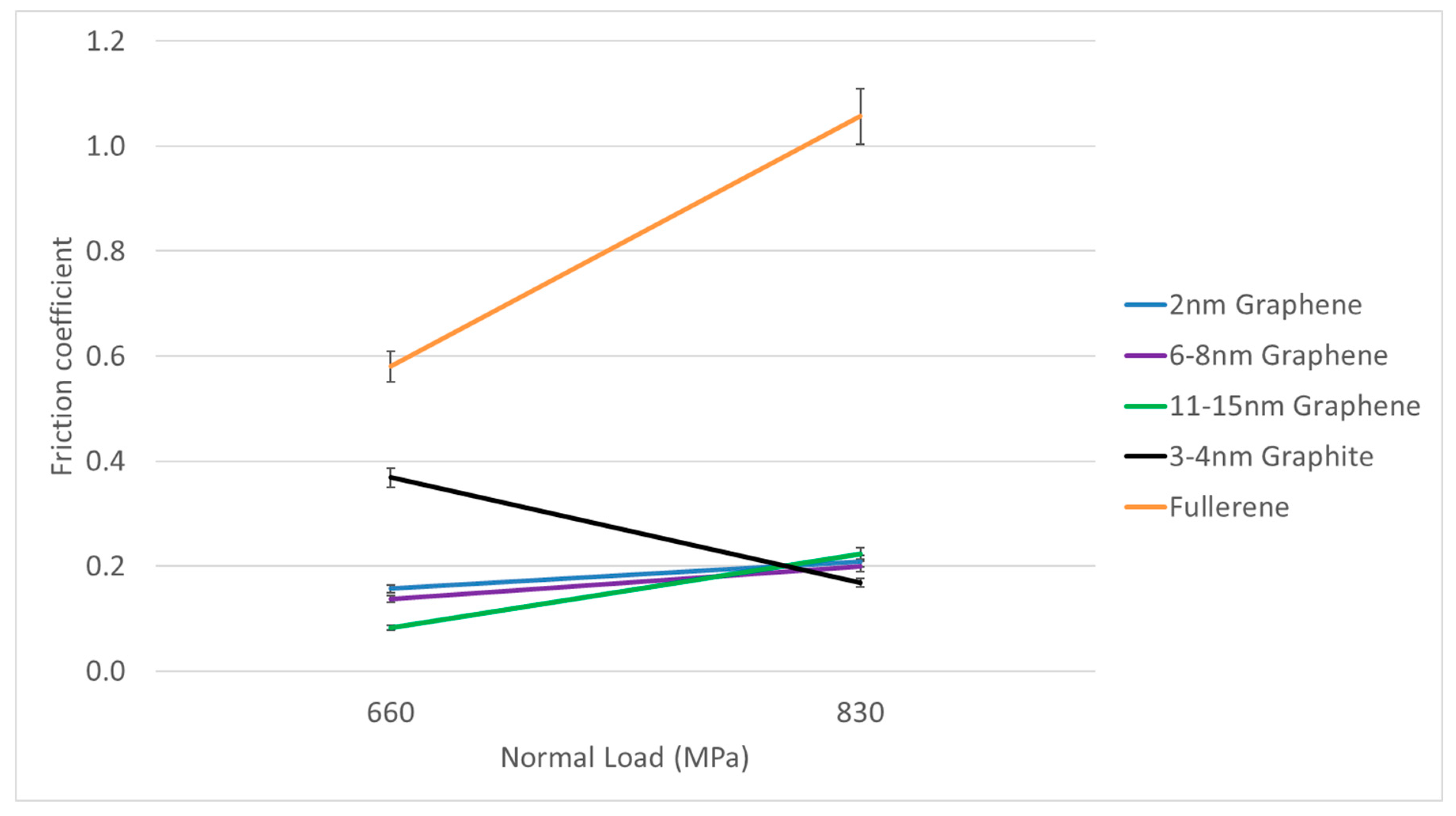1. Introduction
Lubricants play a crucial role in minimizing friction and wear between components in relative motion. However, conventional lubricants may not always be the optimal choice, particularly under extreme environmental conditions or sporadic usage. Current research is emphasizing the exploration of lubricants with enhanced extreme pressure and anti-wear properties to address these challenges. Carbon nanomaterials have attracted much attention as lubricant additives due to their unique nanoscale structure and extremely high thermal and mechanical conductivity. As research progresses, distinctions in the lubricating properties of carbon nanomaterials have been identified under varying conditions.
Graphene, as an allotrope of carbon, is a two-dimensional (2D) layer consisting of covalently bonded carbon atoms. Compared to graphite, graphene offers better sliding properties and improved thermal conductivity, which is important for the transfer of heat from the tribological contacts [
1]. In addition, graphene has a higher electrical conductivity [
2]. When applying graphene in journal bearings, Chemical Vapor Deposition (CVD) coatings were employed, yielding a noteworthy reduction in both friction and power consumption [
3]. To study a graphene additive film in n-hexadecance lubricating oil Zhang et al. performed pin-on-disk tests and molecular dynamic studies. It was found that the adsorption of the lubricant could be increased by adding graphene and shear stresses on the surface were reduced [
4]. Wu et al. studied graphene oxide nanoplatelets as lubricant additive for the contact of Si3N4 ceramic / GCr15 steel in a four ball tester. They demonstrated not only a reduction in friction but also enhanced wear resistance and load-carrying capacity through the incorporation of Graphene oxide additives [
5].
Initially, nanomaterials found application exclusively in specific conditions like elevated temperatures and vacuum environments, where traditional organic lubricants were unsuitable. Nanotechnology enables precise tuning of nanoparticle shape, size, and surface groups, enhancing their potential for applications in various fields, including colloidal systems like lubricating greases, oil recovery, and biomedicine [
6]. The addition of nanoparticles to lubricating oil can effectively reduce the boundary friction and increase the wear resistance of the lubricating oil. Carbon nanomaterials like graphene and its derivatives, carbon nanospheres, fullerenes, etc., serve as vital components of nanoparticles and find diverse applications in contemporary research. Another emerging material is Ti
3C
2T
x nanosheets (MXene), which have advantageous sliding planes for dry lubrication [
7]. Graphene exhibits distinctive physical and chemical properties, combining high chemical inertia, exceptional strength, and low shear strength. As additive to liquid lubricants such as lubricating and cutting oil, it can improve lubrication, friction reduction and anti-wear properties [
8,
9].
Studies of graphene platelets as grease additive could prove the outstanding effect as 2D nano-material in reducing friction and wear, as shown by Pape et al. [
10,
11,
12] as well as by Nassef et al. [
13,
14,
15]. Kim et al. achieved good lubricating conditions for reduced graphene oxide (rGO) coatings on AISI 440C stainless steel balls sliding against a silicon specimen under water lubrication conditions [
16]. At the same time, the gas and liquid impermeability of graphene can effectively delay the corrosion and oxidation process of the friction surface, and its distinguished thermal conductivity can lower the temperature generated on the surface. This reduces the decomposition process of the surfaces during the tribological contact. A molecular dynamics study on the interlayer sliding behavior of a few layers of graphene was conducted by Xu et al. Coherent sliding at several interfaces and a periodic layer transition were demonstrated [
17]. Restuccia et al. demonstrated the chemisorption of graphene on iron substrate, while the bonding is enhanced by reactive protruding bonds. The surface-surface mechanism of interaction changes from chemical to physical due to the passivation effect caused by graphene, which reduces adhesion and friction [
18]. In case of hot rolling, Wang et al. proved the ability of graphene nanoplatelets to serve as dry lubricant up to 960°C [
19]. Regarding the thickness and particle size of graphene platelets as lubricant additive, Kong et al. demonstrated that thicker layers and smaller particle size have better positive effect on the tribological performance as lubricant additive [
20].
Fullerene has been explored in numerous studies as a dry lubricant, displaying superior friction conditions to graphite, particularly in very dry air (< 35% relative humidity). Its friction coefficient exhibits minimal temperature dependence, providing advantages over traditional dry lubricants, especially in extreme conditions [
21]. In composite materials, such as when embedded in epoxy resin, fullerene has the potential to significantly reduce wear [
22].
Graphite, employed as a dry lubricant, exhibits favorable properties and finds widespread use in tribological contacts with low contact pressures. While predominantly applied as a thicker coat, it has not gained prominence in bearing applications. In the study of Suparno et al. the authors highlighted graphite's effective dry lubrication potential in the tribological rail-wheel contact, where it adhered to the wheel surface and permeates fissures, resulting in minimal wear [
23]. While Morstein et al. investigation into the frictional properties of graphite in reciprocating sliding tests yielded a compressed thin carbon film with low friction [
24].
The application of graphene platelets on bearing surfaces allows for significantly thinner coatings, contributing to extended running times in bearing applications. Graphene platelets, consisting of a few layers of graphene with a diameter in the µm range, can be efficiently produced on a large scale through graphite exfoliation. When used as an additive to grease, graphene platelets can form protective films between sliding surfaces, particularly effective under lubricant-starved conditions as encountered in oscillating motion. Pape and Poll have demonstrated this effect in the case of graphene platelets used as dry lubricants [
11].
In their study, thin layers of graphene platelets were subjected to a Hertzian pressure of 1.5 GPa in angular contact ball bearings. These bearings, characterized by both rolling and spinning motion along with Heathcote slip, revealed that the layer thickness of the platelets significantly influences the frictional torque. It is inferred that the rolling motion contributes to the formation of a compressed graphene platelets based layer with a thickness of a few tens of nanometers. These layers exhibit superior tribological properties and can withstand high tribological loads encountered in rolling bearing contacts.
Figure 1 illustrates SEM images of the raceway and a bearing ball after testing on a rig (1.3 million cycles tested under 48% degree of reciprocating motion), with detailed information available in [
11]. A thin dry lubricant film based on graphene platelets formed on the surface. On the counterpart, including the ball itself and the outer bearing ring, a transfer film developed, resulting in low friction and prolonged running time. The hardness was assessed using a Hysitron/Bruker Nanoindenter (TriboIndenter TI 950, Bruker Corporation, Billerica, Massachusetts, US) as described in [
25]. Prior to the test, the hardness of the uncoated bearing surface was 9.2 GPa; after the pivoting test, the hardness of the raceway dropped to 7.3 GPa. The hardness of the accumulated graphene platelets was approximately 0.3 GPa.
Furthermore, the graphene layers underwent examination using Raman spectroscopy (
Figure 2). For the measurement an alpha300 RA Raman-AFM Microscope was used (Oxford Instruments, Abingdon, England). The 2D peak around 2690 cm
-1, with a half-width of 105 cm
-1 (half-width of the monolayer ≈ 24 cm
-1), indicates stacked graphene. The measurement before and after exposure reveals a distinct G peak at 1591 cm
-1, typical for graphene, which splits into the G and two D peaks when graphene has defects. The intensity of the D peak at 1351 cm
-1, signifying defects in the graphene structure, notably increased after the panning experiment. These defects may manifest as fractures in the graphene or as charged particles (e.g., metal ions) embedded in the graphene structure. It is plausible to assume that the graphene undergoes wear during the endurance test.
To validate these effects, studies were conducted on the frictional properties under sliding conditions. Graphene platelets were applied as thin layers on bearing steel, undergoing both pre-rolling compaction and direct deposition without compaction.
2. Test Setup and Materials
For the experiments graphene nanoplatelets were utilized sourced from IOLITEC (IoLiTec-Ionic Liquids Technologies GmbH, Heilbronn, Germany), with staple thicknesses of 2 nm, 6-8 nm, and 11-15 nm. Nano graphite powder (3-4 nm diameter) and fullerene (C60/C70 bucky balls) were employed to assess their impacts in the tribo contact (also purchased by IOLITEC). The graphene platelets, nano graphite, and fullerene were precisely weighed and combined with Dimethylformamid. To mitigate agglomeration and achieve a well-dispersed suspension, the mixtures underwent ultrasonic treatment for 1 hour.
Subsequently, the mixtures underwent a 10-minute treatment in an ultrasonic homogenizer. Bearing washers, specifically type WS81102 (manufactured by Schaeffler, Herzogenaurach, Germany), crafted from bearing steel AISI 52100, were then coated by brushing them with the prepared mixtures. To secure the applied coating, the bearings were placed in an oven at 120°C for 15 minutes. The Tribotechnic MILLI TRIBOtester (Tribotechnic, Clichy, France) was employed to qualify the coatings.
In this setup, a plate undergoes linear reciprocating motion against a fixed pin. To elucidate the mechanism of the beneficial effect for angular contact ball bearings, the investigations were conducted in two steps, as shown in
Figure 3. In the first step a rolling ball moved in oscillating motion along the graphene platelets covered sample to achieve a compressed film of graphene platelets with parameters as shown in
Table 1. The setup at the tribometer is shown in
Figure 4. Whereas the second step involves examining the frictional properties of the film using a sliding test with parameters shown in
Table 2, the setup is depicted in
Figure 5. For comparison, measurements were performed with the uncompressed dry lubricants. The test setup allows applying normal pressure by a carbon fiber cantilever arm with a frictionless cardan bearing system. An integrated sensor records the arm's tangential elongation in order to calculate the friction. For the rolling process, ball rollers with a diameter of 5mm made of AISI 52100 were used. While the sliding tests employed AISI 52100 balls with a diameter of 6 mm. Therefore, the material of the counterpart and pin is the same as that found in real bearing applications. The tracks resulting from sliding on the bearing washers were observed using a Keyence Laser Scanning microscope (KeyenceVK-X200, Keyence, Osaka, Japan).
3. The effect of Pre-rolling on the lubricating properties of lubricants
In the initial stage, the dry lubricant coatings were examined in the tribometer without the pre-rolling process. For this investigation, the normal load was set to 1 N (660 MPa contact pressure), the sliding speed was 1mm/s, and the track length was 2 mm. The measured friction force on the sample after using the five dry lubricants is depicted in
Figure 6. It is evident that nano graphite, 6-8 nm graphene platelets, and fullerene did not exhibit friction reduction under these test conditions. During the test, these dry lubricants were displaced from the contact area, leading to steel-steel contact and resulting in high friction. Conversely, in the case of 2 nm graphene platelets and 11-15 nm graphene platelets, a film was formed, featuring a low coefficient of friction (COF). In these instances, a compact film could be established, while the other dry lubricants were removed from the raceway.
Before repeating the test, a pre-rolling step was performed on a fresh coated surface. By employing this method, a rolling ball with a diameter of 5 mm was utilized, oscillating at 1 mm/s, covering a track length of 2 mm along a race track for a duration of 15 minutes, with a load of 3 N applied, equals approx. 1 GPa contact pressure. Subsequently, a compressed film was attained on the surface. The sliding test was then conducted directly on this compacted film as the second step.
The friction coefficient after the pre rolling step was measured under same conditions as before at a sliding speed of 1 mm/s, a normal load of 1 N and track length of 2 mm. From
Figure 7, it can be seen that the COF using 11-15 nm graphene platelet dry lubricant recorded the lowest value, followed by that using 6-8 nm graphene platelet dry lubricant. However, the COF in the case of fullerene was the highest. While COF for nano graphite could be decreased but still remains in the range of 0.4 to 0.5, a value much higher than that observed for graphene platelets, which ranges from below 0.1 to below 0.2.
Through the above comparison, whether or not pre-rolling has the greatest effect on the friction coefficient of the samples using 6-8 nm graphene platelets and 3-4 nm graphite dry lubricant. Also the curves for the dry lubricants feature lower fluctuations due to the compressed and more stable dry lubrication film.
4. The effect of sliding contact pressure on the lubricating properties
To investigate higher contact pressure, the tests were repeated under 2 N load (83 MPa contact pressure). In this case a new sample was pre-rolled with the rolling ball of 5 mm diameter. For the sliding tests, the sliding speed and the track length were 1 mm/s and 2 mm, respectively. The measured COF values for the five dry lubricant cases are shown in
Figure 8. As the load increases to 2 N, the COF of both graphene platelets and nano graphite samples is considered almost the same.
Under these challenging conditions, the COF on samples using 3-4 nm graphite dry lubricant is the lowest among the group. Conversely, the friction coefficient measured by the sample using fullerene dry lubricant is significantly higher than that of other dry lubricants, indicating that no compacted dry lubricant film could be achieved. This highlights the poorer lubricating property of fullerene dry lubricant under these conditions. In conclusion, when the normal load is 2 N, sliding speed is 1 mm/s, and the track length is 2 mm, the lubricating properties of 3-4 nm graphite and graphene platelets are nearly comparable to typical lubricated contacts, with a COF between 0.1 to 0.15 under similar test conditions [
26,
27].
5. Microscopic investigation
The balls and raceways were investigated in terms of Laser Scanning Microscopy (KeyenceVK-X200).
Figure 9 shows the balls after the sliding test under pre-rolling with a pressure value of 830 MPa. The figure reveals the surface image on left and the respective profile on right, in order to conclude on the ball wear.
The comparison of the wear spot area on the steel ball surface when using different types of lubricants proves the formation of a wear protective film by graphene platelets. As depicted in
Figure 9, under identical load (830 MPa contact pressure), speed, and track length conditions, the wear spot area on the steel ball surface is the smallest when using graphene platelets as a dry lubricant. In comparison the fullerene dry lubricant resulted on significant wear on the balls surface. Regarding nano graphite, a slight amount of wear can be found on the surface. The steel ball using fullerene dry lubricant indicates the largest wear spot area, which is roughly consistent with the variation of the wear degree under microscope. The contrast between graphene platelets as dry lubricant (in this case 2 nm staple thickness) and fullerene is also visualized in
Figure 10. A plateau is formed on the surface of the steel ball in case of the fullerene dry lubricant, while for graphene platelets no wear can be found. The images prove that a small portion of graphene platelets were transferred to the balls surface and can feature a significant enhancement as dry lubricant.
The respective dry lubricated racetracks for graphene platelet dry lubricant (6-8 nm graphene platelets) and fullerene are illustrated in
Figure 11. The surfaces were analyzed by Laser Scanning microscopy. It can be seen that the graphene platelets form a dense film on the surface with a thickness of approx. 150 to 200 nm in the central contact zone. In contrast, for the fullerene on the surface, wear is evident, with the base material being removed to a depth of up to 2.5 µm.
In case of the compacted graphene platelet based track for the sample run with 6-8 nm thick graphene platelets, nanoindents were performed with indentation depth from 40 to 45 nm. For the measurements a Bruker Hysitron TriboIndenter TI 950 (Bruker Corporation, Billerica, Massachusetts, US) with Berkovich tip was used. A hardness of 0.65 GPa and a Young’s Modulus of 32 GPa were achieved. The compacted graphene film used for measurements is shown in
Figure 12 (on the left is Scanning Probe Image with measurement points and on the right is microscopic view of the surface). The compacted graphene platelets feature elastoplastic material behavior. Then, after indentation, the material features elasto-plastical properties as shown in the load-displacement curves for the respective nanoindents (
Figure 13). The SPM image proves a surface smoothening and a fine surface structure, recording slightly higher hardness, as compared to the compacted graphene platelets on the angular contact ball bearings.
5. Discussion
In this study, the formation of a compacted dry lubricant film on steel surfaces was demonstrated. This film exhibits mechanical properties similar to the film identified on angular contact ball bearings tested with graphene platelets as dry lubricant. When a compact film forms on the surface, it introduces a fine roughness, contributing to improved sliding conditions. The asperities of the steel surface are covered and a direct steel - steel contact can be avoided. When it comes to spherical nanoparticles, such as those found in fullerene, no compacted film is formed. Consequently, the surfaces are more susceptible to wear. It can be inferred that carbon-based nanoparticles help inhibit surface oxidation, thereby mitigating increased friction. An interesting alternative is the utilization of nano graphite. Under higher pressure, specifically 830 MPa, a lower coefficient of friction (COF) was attained. In this scenario, favorable sliding planes contribute to enhanced frictional properties. The presence of a stable, compacted film on the surface suggests that, owing to the thin film with a reduced Young’s Modulus, the contact pressure is likely slightly diminished. This reduction in contact pressure mitigates the occurrence of pressure peaks on roughness asperities. A secondary effect is the formation of a transfer film on the steel counterpart, preventing oxidation and smoothing the counterpart surface. The pre-rolling process can affect the friction under sliding significantly. Especially in case of the 6-8 nm graphene platelets this could be shown.
Figure 14 shows the comparison of the sliding friction for the samples with and without pre-rolling. It is obvious, that in case of the nano graphite and 6-8 nm graphene platelets, the sliding friction experienced a significant reduction. As for 11-15 nm thick graphene platelets, this effect becomes a little visible, but not that distinctive. Regarding the 2 nm graphene platelets, the sliding friction remained nearly on the same level of low COF.
As illustrated in
Figure 15, with an increase in load to 2 N, the COF for the graphene platelets coated samples with pre-rolling slightly rose to approximately 0.2. However, when employing the 3-4 nm nano graphite dry lubricant, a substantial reduction in the friction coefficient was observed. In this instance, additional compaction may contribute to the formation of an improved sliding surface. Conversely, the use of fullerene resulted in a significant increase in COF with an escalating load.
As depicted in the aforementioned figures, it is evident that the utilization of dry lubricants, specifically 2 nm graphene platelets and 11-15 nm graphene platelets, exhibits minimal variation in the friction coefficient under different parameter conditions. Contrastingly, when employing the dry lubricants 3-4 nm graphite and 6-8 nm graphene platelets, alterations in parameter conditions exert a more pronounced influence on the friction coefficient.
In comparison to contacts lubricated with oil and grease, dry lubricants can exhibit nearly identical lower coefficients of friction (COF) under sliding conditions. This observation was initially demonstrated in the comparison between grease-lubricated angular contact ball bearings and their dry-lubricated counterparts [
10,
11,
12] and has now been confirmed through tribometer investigations.
5. Conclusion
In this study, five various dry lubricants were prepared, namely 2 nm graphene platelets, 6–8 nm graphene platelets, 11–15 nm graphene platelets, 3–4 nm nano graphite and fullerene (C60/C70). The friction under reciprocating motion was investigated to draw conclusions on the film formation and lubrication mechanism. It is found from microscopic observations that the graphene dry lubricant had the best anti-wear and anti-friction properties. In the absence of pre-rolling, the 2 nm and 11–15 nm graphene platelets demonstrated the most effective lubricating properties, forming a compact film. In contrast, the other dry lubricants were displaced from the raceway.
During sliding contact, adjustments to corresponding parameters can influence the lubricating properties of the aforementioned dry lubricants to some extent. Generally, graphene exhibits better lubrication effects compared to graphite and fullerene. The amount of dry lubricant adhered to the friction surface decreases with friction movement, and thicker layers result in a higher remaining amount, thereby optimizing lubrication effects. The transfer of graphene platelets to the sliding ball has been substantiated. Pre-rolling the dry-lubricant coating establishes a friction coefficient in the range comparable to oil or grease lubricated sliding contacts. The study proved previous investigations on angular contact ball bearings showing the ability of graphene platelets as dry lubricants to protect tribological contacts especially under reciprocating motion. It is helpful to perform a compacting of the respective dry lubricant film to achieve a low friction and nearly no wear on the contacting surfaces.
It can be concluded that graphene platelets, as 2D materials with excellent sliding properties, offer significant advantages as dry lubricants over fullerene, which acts as nanoparticles in the contact zone. Graphite nanoparticles exhibit slight wear on the surface, while maintaining good frictional properties. This study validates previous investigations on angular contact ball bearings, demonstrating the efficacy of graphene platelets as dry lubricants in protecting tribological contacts, especially under reciprocating motion. The compaction of the respective dry lubricant film is crucial to achieving low friction and minimal wear on the contacting surfaces. This type of lubricant showcases promising properties, and given the ease of production of graphene platelets through mechanical exfoliation, it is anticipated to gain traction in the market. Potential applications include bearings under reciprocating motion.
Funding
The publication of this article was funded by the Open Access Fund of Leibniz Universität Hannover.
Institutional Review Board Statement
“Not applicable” for studies not involving humans or animals.
Data Availability Statement
The datasets of the study can be requested from the author.
Acknowledgments
The author would like to thank Prof. Dr.-Ing. B.-A. Behrens and N. Mohnfeld from Leibniz University Hanover, Institute of Forming Technology and Forming Machines and Prof. Prof. h.c. Dr.-Ing. Glasmacher and Dr.-Ing. S. Knigge from Leibniz University Hanover, Institute for Multiphase Processes for their support in researching the dry lubrication mechanism of graphene platelets. I would also like to thank Prof. Dr.-Ing. G. Poll (IMKT, Leibniz University Hanover) for supporting these investigations and Prof. Dr.-Ing. H.-H. Gatzen (Institute of Micro Production Technology (former Institute for Microtechnology) Leibniz University Hanover) for initiating the investigations on carbon-based nanoparticles.
Conflicts of Interest
The authors declare no conflict of interest. The funders had no role in the design of the study; in the collection, analyses, or interpretation of data; in the writing of the manuscript, or in the decision to publish the results.
References
- Ghosh, S., Calizo, I., Teweldebrhan, D., Pokatilov, E. P., Nika, D. L., Balandin, A. A., ... & Lau, C. N. (2008). Extremely high thermal conductivity of graphene: Prospects for thermal management applications in nanoelectronic circuits. Applied Physics Letters, 92(15). [CrossRef]
- Marinho, B., Ghislandi, M., Tkalya, E., Koning, C. E., & de With, G. (2012). Electrical conductivity of compacts of graphene, multi-wall carbon nanotubes, carbon black, and graphite powder. Powder technology, 221, 351-358. [CrossRef]
- Wang, X. B., Zhang, Y. F., & Yin, Z. W. (2020). Frequent start-stop test study of graphene coatings on journal bearings. Key Engineering Materials, 841, 26-35. [CrossRef]
- Zhang, L., Lu, B., Wu, Y., Wang, J., Zhang, X., Wang, L., & Xi, D. (2020). Molecular dynamics simulation and experimental study on the lubrication of graphene additive films. Proceedings of the Institution of Mechanical Engineers, Part J: Journal of Engineering Tribology, 234(12), 1957-1972. [CrossRef]
- Wu, L., Xie, Z., Gu, L., Song, B., & Wang, L. (2018). Investigation of the tribological behavior of graphene oxide nanoplates as lubricant additives for ceramic/steel contact. Tribology International, 128, 113-120. [CrossRef]
- GU Yu-Kang, CAO Lei, WAN Yong, GAO Jian-Guo. Tribological Performance and Lubrication Mechanism of Carbon Microspheres as Oil-based Lubricant Additive on Aluminum Alloy Substrate[J]. Journal of Inorganic Materials, 2017, 32(6): 625-630.
- Mar Max Marian, Gui Cheng Song, Bo Wang, Victor M. Fuenzalida, Sebastian Krauß, Benoit Merle, Stephan Tremmel, Sandro Wartzack, Jinhong Yu, Andreas Rosenkranz, Effective usage of 2D MXene nanosheets as solid lubricant – Influence of contact pressure and relative humidity, Applied Surface Science, Volume 531, 2020, 147311, ISSN 0169-4332. [CrossRef]
- Nassef, B. G., Pape, F., & Poll, G. (2023). Enhancing the Performance of Rapeseed Oil Lubricant for Machinery Component Applications through Hybrid Blends of Nanoadditives. Lubricants, 11(11), 479. [CrossRef]
- Berman, D., Erdemir, A., & Sumant, A. V. (2014). Graphene: a new emerging lubricant. Materials today, 17(1), 31-42. [CrossRef]
- Pape F, Knigge S, Glasmacher B, Poll G, Graphene based dry lubrication in rolling contacts, Proceedings, LUBMAT 2018, 5-6th Juni 2018, San Sebastian, Spanien, 2018.
- Pape, F., & Poll, G. (2020). Investigations on graphene platelets as dry lubricant and as grease additive for sliding contacts and rolling bearing application. Lubricants, 8(1), 3. [CrossRef]
- Pape F, Poll G, Graphenbasierte Schmierung von Wälzlagern, Tribologie + Schmierungstechnik, 66, S. 26–31, 2019. [CrossRef]
- Nassef, M. G., Soliman, M., Nassef, B. G., Daha, M. A., & Nassef, G. A. (2022). Impact of graphene nano-additives to lithium grease on the dynamic and tribological behavior of rolling bearings. Lubricants, 10(2), 29. [CrossRef]
- Nassef, M. G., Hassan, H. S., Nassef, G. A., Nassef, B. G., Soliman, M., & Elkady, M. F. (2022). Activated Carbon Nano-Particles from Recycled Polymers Waste as a Novel Nano-Additive to Grease Lubrication. Lubricants, 10(9), 214. [CrossRef]
- Nassef, B. G., El-Labban, H., Al-Oufy, A., & Daha, M. A. (2022). Effect of Graphene Addition to Lithium-Based Grease on the Performance of Rolling Element Bearings. Key Engineering Materials, 913, 279-284. [CrossRef]
- Kim, H. J., Shin, D. G., & Kim, D. E. (2016). Frictional behavior between silicon and steel coated with graphene oxide in dry sliding and water lubrication conditions. International Journal of Precision Engineering and Manufacturing-Green Technology, 3, 91-97. [CrossRef]
- Xu, L., Ma, T. B., Hu, Y. Z., & Wang, H. (2012). Molecular dynamics simulation of the interlayer sliding behavior in few-layer graphene. Carbon, 50(3), 1025-1032. [CrossRef]
- Restuccia, P., & Righi, M. C. (2016). Tribochemistry of graphene on iron and its possible role in lubrication of steel. Carbon, 106, 118-124. [CrossRef]
- Wang, L., Tieu, A. K., Ma, M., Li, J., Hai, G., & Zhu, H. (2022). Potential application of graphene nanoplatelets as a high temperature lubricant for hot rolling. Friction, 10(11), 1810-1823. [CrossRef]
- Kong, S., Wang, J., Hu, W., & Li, J. (2020). Effects of thickness and particle size on tribological properties of graphene as lubricant additive. Tribology Letters, 68, 1-10. [CrossRef]
- Vijayaraghavan, A., Iliut, M. (2017). Graphene. In: Bhushan, B. (eds) Springer Handbook of Nanotechnology. Springer Handbooks. Springer, Berlin, Heidelberg. [CrossRef]
- Pape, F., Rissing, L., Gatzen, H.H.: Fabrication and tribological investigation of fullerene C60/C70 reinforced epoxy resin SU-8™, Tribologie und Schmierungstechnik 58(4):51-55, 2011.
- Suparno, J., Halim, D. A., Junaidi, Setiawan, A., Effendy, M., & Jamari, J. (2019). Graphite as Dry Lubricant to Reduce Rail Wheels Wear Level. In Materials Science Forum (Vol. 961, pp. 126–133). Trans Tech Publications, Ltd. [CrossRef]
- Morstein, C. E., & Dienwiebel, M. (2021). Graphite lubrication mechanisms under high mechanical load. Wear, 477, 203794. [CrossRef]
- Pape F, Mikrotribologische Untersuchungen an Wälzlagern mit polymeradditiver Fettschmierung, Dissertation, Institut für Mikrotechnologie, Leibniz Universität Hannover, 2011.
- Pape, F. (2022). Nano-and Micro-Tribological Investigations of Boundary Layers on Axial Bearing Washers Tested under WEC Critical Conditions. Lubricants, 10(8), 198. [CrossRef]
- Pape, F., Poll, G., Ellersiek, L., Denkena, B., & Liu, H. (2023). Tribological Effects of Metalworking Fluids in Cutting Processes. Lubricants, 11(5), 224. [CrossRef]
Figure 1.
SEM micrograph of graphene platelet film on angular contact ball bearing raceway (a) and ball (b) after endurance test as described in [
11].
Figure 1.
SEM micrograph of graphene platelet film on angular contact ball bearing raceway (a) and ball (b) after endurance test as described in [
11].
Figure 2.
Raman spectroscopy (wavelength 520nm, intensity 0.1mW) of a graphene platelets lubricated bearing before loading (blue) and after endurance test (red) as described in [
11]. The typical G-peak for graphene is clearly visible in the dry lubrication layer before loading. After loading in the pivoting test, the increase in the intensity of the D peak indicates the occurrence of defects in the graphene structure. The 2D peak shows how many layers of graphene are on top of each other.
Figure 2.
Raman spectroscopy (wavelength 520nm, intensity 0.1mW) of a graphene platelets lubricated bearing before loading (blue) and after endurance test (red) as described in [
11]. The typical G-peak for graphene is clearly visible in the dry lubrication layer before loading. After loading in the pivoting test, the increase in the intensity of the D peak indicates the occurrence of defects in the graphene structure. The 2D peak shows how many layers of graphene are on top of each other.
Figure 3.
Test principle: a) loading the dry coated sample, b) pre-rolling under load and subsequent compacting, c) test on compacted dry lubricant coating.
Figure 3.
Test principle: a) loading the dry coated sample, b) pre-rolling under load and subsequent compacting, c) test on compacted dry lubricant coating.
Figure 4.
Setup for pre-rolling in milli tribometer, on the left the roller for the pre-rolling process is shown.
Figure 4.
Setup for pre-rolling in milli tribometer, on the left the roller for the pre-rolling process is shown.
Figure 5.
Setup for friction measurement in milli tribometer.
Figure 5.
Setup for friction measurement in milli tribometer.
Figure 6.
Friction coefficient on steel coated with graphene platelets, nano graphite and fullerene without pre-rolling, tested under 660 MPa.
Figure 6.
Friction coefficient on steel coated with graphene platelets, nano graphite and fullerene without pre-rolling, tested under 660 MPa.
Figure 7.
Friction coefficient on steel coated with graphene platelets, nano graphite and fullerene with pre-rolling, tested under 660 MPa.
Figure 7.
Friction coefficient on steel coated with graphene platelets, nano graphite and fullerene with pre-rolling, tested under 660 MPa.
Figure 8.
Friction coefficient on steel coated with graphene platelets, nano graphite and fullerene with pre-rolling, tested under 830 MPa.
Figure 8.
Friction coefficient on steel coated with graphene platelets, nano graphite and fullerene with pre-rolling, tested under 830 MPa.
Figure 9.
Wear spot of steel ball under 3D Laser Scanning Microscope tested against pre rolled dry lubricants under 830 MPa contact pressure after sliding test for a) 2 nm thick Graphene platelets, b) 6-8 nm thick Graphene platelets, c) 11-15 nm thick Graphene platelets, d) 3-4 nm nano Graphite, e) Fullerene.
Figure 9.
Wear spot of steel ball under 3D Laser Scanning Microscope tested against pre rolled dry lubricants under 830 MPa contact pressure after sliding test for a) 2 nm thick Graphene platelets, b) 6-8 nm thick Graphene platelets, c) 11-15 nm thick Graphene platelets, d) 3-4 nm nano Graphite, e) Fullerene.
Figure 10.
Comparison of the surface for the ball tested against pre rolled 2 nm graphene platelets (a) and fullerene (b) after sliding test (830 MPa contact pressure).
Figure 10.
Comparison of the surface for the ball tested against pre rolled 2 nm graphene platelets (a) and fullerene (b) after sliding test (830 MPa contact pressure).
Figure 11.
Comparison of the bearing washers surface coated with pre rolled 6-8 nm graphene platelets (a) and fullerene (b) after sliding test (830 MPa contact pressure).
Figure 11.
Comparison of the bearing washers surface coated with pre rolled 6-8 nm graphene platelets (a) and fullerene (b) after sliding test (830 MPa contact pressure).
Figure 12.
Surface for nanoindentational study after test with pre-rolled 6-8 nm thick graphene platelets under 660 MPa (on the left: Scanning Probe Microscopy of the surface 25 x 25µm, on the right: light microscopic view).
Figure 12.
Surface for nanoindentational study after test with pre-rolled 6-8 nm thick graphene platelets under 660 MPa (on the left: Scanning Probe Microscopy of the surface 25 x 25µm, on the right: light microscopic view).
Figure 13.
Nanoindents on surface after test with pre-rolled 6-8 nm thick graphene platelets under 660 MPa.
Figure 13.
Nanoindents on surface after test with pre-rolled 6-8 nm thick graphene platelets under 660 MPa.
Figure 14.
Comparison of frictional coefficients for dry lubricants with and without pre-rolling.
Figure 14.
Comparison of frictional coefficients for dry lubricants with and without pre-rolling.
Figure 15.
Comparison of frictional coefficients for pre-rolled dry lubricants under 660 MPa and 830 MPa pressure, after pre-rolling.
Figure 15.
Comparison of frictional coefficients for pre-rolled dry lubricants under 660 MPa and 830 MPa pressure, after pre-rolling.
Table 1.
Setup pre-rolling conditions.
Table 1.
Setup pre-rolling conditions.
| Diameter of the ball |
5 mm (100Cr6 / AISI 52100) |
| Track length |
2 mm |
| Sliding speed |
1 mm/s |
| Sliding length |
1 m |
| Normal load |
3 N |
| Pressure |
1073 MPa |
| Duration |
15 minutes |
Table 2.
Sliding test conditions.
Table 2.
Sliding test conditions.
| Diameter of the ball |
6 mm (100Cr6 / AISI 52100) |
| Track length |
2 mm |
| Sliding speed |
1 mm/s |
| Sliding length |
4m |
| Normal load |
1 N, 2 N |
| Pressure |
660 MPa, 830 MPa |
| Duration |
1 h |
|
Disclaimer/Publisher’s Note: The statements, opinions and data contained in all publications are solely those of the individual author(s) and contributor(s) and not of MDPI and/or the editor(s). MDPI and/or the editor(s) disclaim responsibility for any injury to people or property resulting from any ideas, methods, instructions or products referred to in the content. |
© 2023 by the authors. Licensee MDPI, Basel, Switzerland. This article is an open access article distributed under the terms and conditions of the Creative Commons Attribution (CC BY) license (http://creativecommons.org/licenses/by/4.0/).
